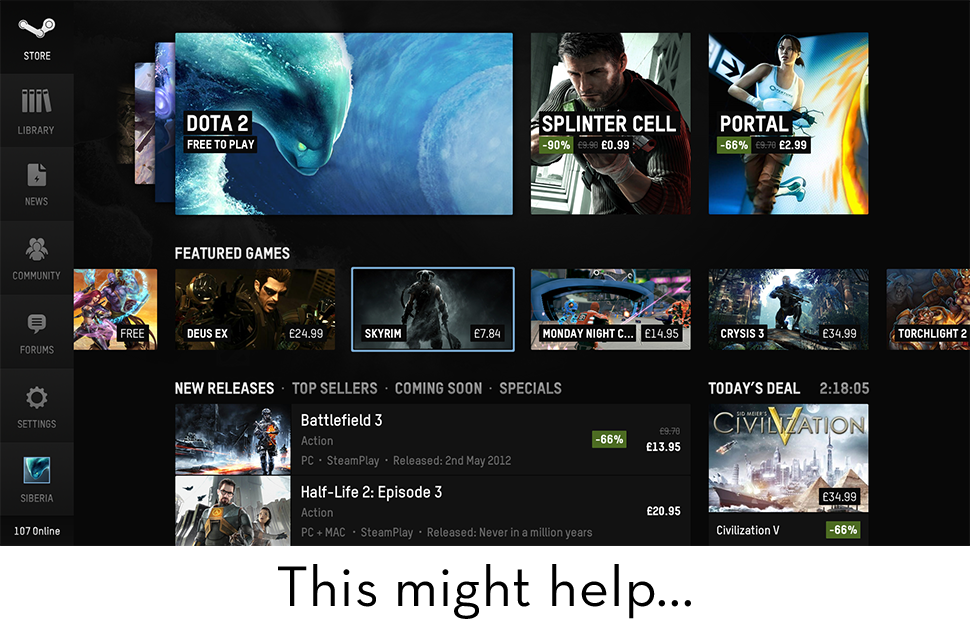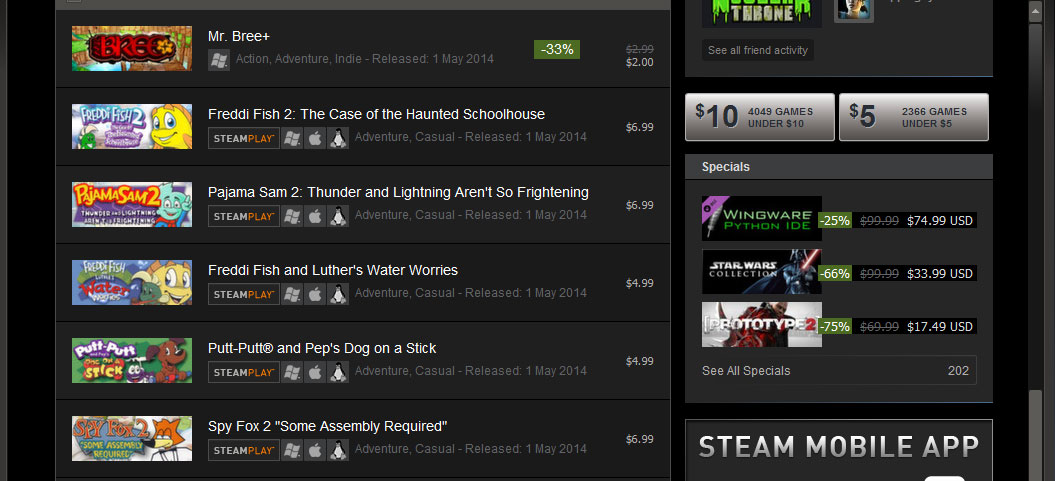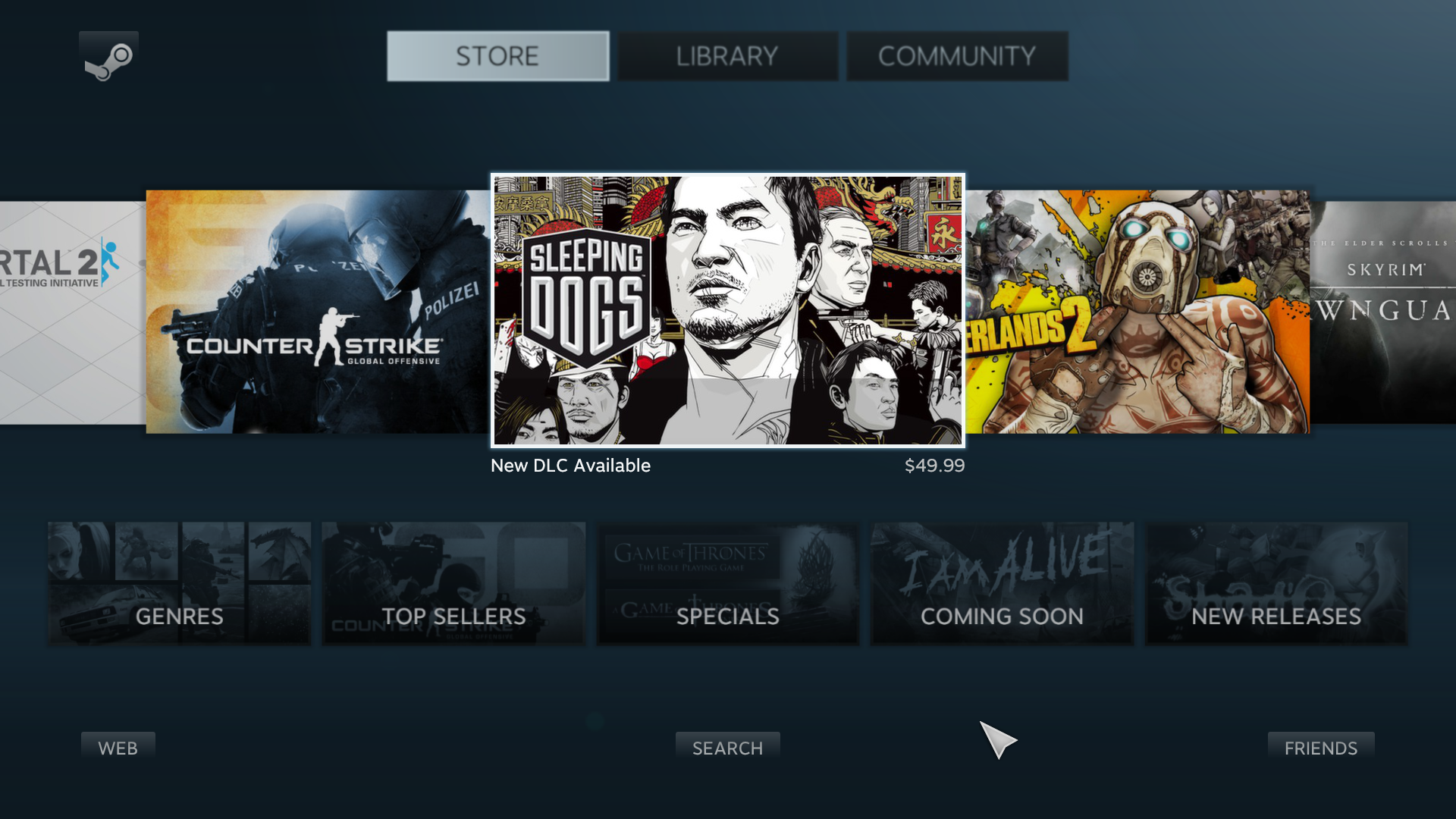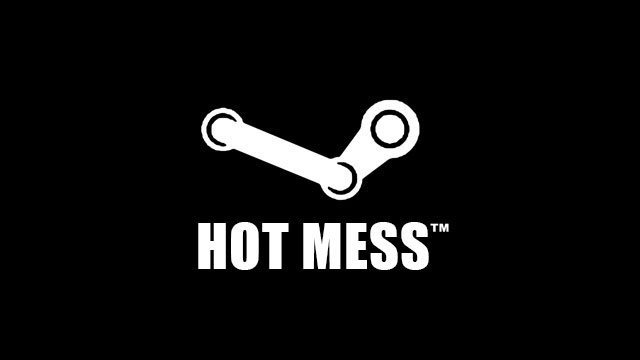Steam is great for so many things. Online play, copy-protection, update management, silly sale prices. You know what Steam’s not great at? Being a store.
I’m not talking about knowing knowing what game you want to buy, opening up Steam and buying it. That’s easy, and not even Steam’s gross design and cluttered UI can stand in your way. I’m talking about those days where you fire up your PC, have $US10 to spend and want to check out what’s new or interesting.
PC gaming isn’t like console or handheld gaming. It’s not pegged to a release schedule of major games. In 2014 PC gaming is a wild and varied thing, with blockbuster releases joined by a seemingly never-ending flood of indie games and early access experiments.

This variety and volume of content means Steam’s marketplace has evolved into something closer to the kind of offerings you find on Apple or Google’s mobile marketplaces. Huge volumes of new titles that, if simply laid out as they were released, would overwhelm the consumer.
But Steam’s client design has not evolved with it. And that’s where the problems come in.
Those mobile stores may be inundated with games – many of them small in scale, and let’s be honest, not that great – but they both have ways of tackling the volume of content and presenting the consumer with a clean, clear and useful means of choosing what game to buy.
First and most importantly, they curate content. Teams at Apple and Google are testing out these games and recommending which ones they like, placing those recommendations in a prominent area on their store. Their tastes might not automatically align with yours, but when someone’s job is to recommend games, whatever they’re picking might at least be worth a shot.
They also clearly and easily organise recent releases into genres. Visit the App Store, for example, and (at time of posting, at least) you’ll see, there on the main front page, perhaps the platform’s most popular type of game, the “endless runner”, given its own section, with new and classic entries included.
Google’s store even gets proactive and will prominently recommend content to you based on your rating and purchase history.
Now look at Steam. It’s primary PC client is a mess.
The two-column arrangement is distracting and inefficient, with content on the smaller right side of the screen often lost as consumers scroll down the page.
It’s also too heavily slanted towards major, promoted releases. Those games – the big ones, the ones that can afford to splash advertisements across the stop of the store – will and should be given top billing. But they don’t need to be taking up the entire screen when you first start the client.
When you finally get to the “meat and potatoes” of Steam’s main store page, the new releases section, it’s a joke. This is the part where a lack of quality control or a desire to curate store content really hurts. Steam simply lists the most recent games released, in order of release, with a tiny thumbnail and no description of what the game actually is or does.

This is daunting for consumers, who are presented with a stream of games that, let’s be honest, look like garbage. Ports of iOS games, broken early access titles, there’s a lot of crap to wade through. It’s become very similar to Netflix, in a way; it looks like there’s a lot of stuff to buy, but the volume of content that’s of questionable quality ends up cluttering the service and becomes an annoyance.
This design isn’t just overwhelming for customers, I think it’s hurting indie developers as well. Placement on the “new releases” section might be only time a small team gets any kind of widespread promotion for their game. If it’s an awesome game, one that deserves a wider audience, and it gets buried under a flood of iOS ports that’s a damn shame.
To its credit, Steam does have a number of useful features that could, if better-implemented, alleviate this. It will recommend games to you, only this is stuck behind a tab (it really needs to be part of the main store page), and pushes perhaps its most useful aspect – your friends’ most-played games – to the bottom of its page. Note that this is a mechanical recommendation, not a curated one.
It also lets you perform a search for games, letting you burrow down and filter by genre and even metascore, but again, this is clunkier than it needs to be. If Steam knows I like strategy games, and have played a ton of them, can’t it automatically recommend to me, prominently and on the main store page, 4-6 of the best games that have never entered my library?
Finally, and perhaps best/most perplexing of all, is that Steam already has a great store. The one used in the service’s Big Picture mode, designed specifically for use on TVs. It streamlines categories and content to a much more manageable state, and looks much nicer to boot.

So what’s the answer? Well, a redesign would be nice. Steam is ugly as sin, and a streamlining of how the content already there is displayed couldn’t hurt.
Smarter (and more prominent) recommendations would also be great. If Steam’s store database can track genre, developer, release date, price change and metascore, surely there’s a more helpful way it can recommend content than it does currently.
Anything more extensive than that, though, would require curated content. Someone (or a team at Valve) actively playing new games and highlighting the best ones.
For Apple and Google, that’s easy, because neither of those companies really makes games. They’re acting as a third-party.
Valve, on the other hand, makes games. Would Valve be that keen to personally recommend a game that, say, does what DOTA 2 does, but only better? Or improves on what made Left 4 Dead such a hit? Advertising and placing a game on a store is one thing; giving a game a personal stamp of approval is something else.
However Valve choose to improve the store, I think we’re at the point where it needs to be done. Steam, as it stands today, was designed for a time when games were released slowly. A few prominent titles a week, a few big ones a month. It could keep on top of it all.
Today, it can’t.

Comments
37 responses to “Steam’s Store Is A Hot Mess”
Would be great to be able to hide some games from your list of “suggested games”. If you haven’t bought CoD because your just don’t play that genre, there is no reason you’ll ever buy it, even at a 75% off sale.
Hahah… 75% off CoD… Hahah good one.
75% off on the Australian price… so 59.99 aud?
Hey it could happen!!!!
After they mark it UP by 90%
hey, activision is as generous as it is innovative!
…see what i did there? *exaggerated chuckle*
Hmm, agree – I would also like to block genre’s or tags from turning up in suggested games. For example, I don’t like Rougelikes, which is kind of a genre but more like a sub-genre. I would like to block them, but also see other Indie games.
EDIT: Urgh, reply fail to @tikanderoga
Fellow friend that get bugged with the post too fast error heh.
I posted this on a story earlier: https://www.youtube.com/watch?v=sLNh5HPbQPo
It’s a couple of months old but it covers a bunch of issues with the Steam store (most of which are also in this article)
Steams new release section is done perfectly. A chronological list of the games and dlc in the order they are released. By doing this all games are treated fairly instead of having 2-3 tripleA games at the top of the list for a week or more
it even has a recommended games page that takes only one click on the main page to access.
It does have that nice kind of impartiality to it.
I just feel sorry for anyone who tries to release their shiny new game in the same week that some 3rd-world-developer gets their entire 1990s back-catalogue approved. 😛
I suppose you don’t use a spam filter or any kind of filter on your email huh? You just impartially read each email in the order in which it arrives, so that each emailer is treated fairly.
Wouldn’t it be great if somebody invented a way to filter the new releases list, so that it only showed the particular kinds of content you are interested in.
first off emails are different, spam emails are spam emails, nobody wants them, they are garbage and most often cons. With the games on steam, you may not be interested in all the new things that pop up but that doesn’t mean that no one else is.
That being said being able to set your own personal filter would be a good addition as an ADDED feature, but i dont want someone deciding i shouldnt see a new release just because they dont like it / wouldn’t recommend it.
Each genre has its own version of the main “featured items” page, complete with featured games, new releases, top sellers and specials. You click Games right at the top and then click on a genre. Similarly you can click on “See popular tags”. Selecting a tag gives you nine games as examples, then you can click on “Browse all” to see a page with the same features as the “featured items” page just like for genres. New releases, top sellers, specials. You can then go ahead and narrow the listing by selecting more tags from a list on the right hand side. This will filter the list further, and you can still view by new releases, top sellers and specials.
There’s an argument to be made that the UI could be improved (I think it’s pretty good as-is), but the store is certainly not lacking this functionality.
I may want Spam filtered out (and literally just spam, which Steam does by not letting every single person in the world put up any game they want at any time, even if it’s a game. There is a process to go through), but I want, and always will want, my emails sorted in chronological order. You picked a bad example, because there is no situation in which I want them ordered in any other way
But they’re not – Number 3 is currently Eurofighter Typhoon, which it says came out on May 3rd 2014. Go to the page for that game, and it’s miraculously released 30 July 2001. It’s not two days old, it’s 12 years old.
I don’t mind old games coming to Steam, but they should be in a separate section so we’re not inundated with a publisher’s back catalogue for no apparent reason.
The problem is that EVERYONE thinks that they are that struggling, under-rated indie developer, when they’re usually not.
500 staff, fancy office, multiple awards, Bethesda: The struggling under-rated indie that could
My biggest peeve with Steam is the completely inconsistent categorization of games with “Local Co-op”, “Co-op” and “Multiplayer”. I can only assume that the categories are self applied, because it’s impossible to consistently determine if a game supports same screen co-op without relying on outside sources like Co-optimus.
“But they don’t need to be taking up the entire screen when you first start the client.”
Uh what? how small is your monitor? Mine takes up like I dunno not even 25% of my screen. Maybe 20% at best
I don’t think I’ve seen a games distribution platform get even close to a completely usable and user friendly state yet. GOG.com would be about the only one that gets close, though its mechanism for managing downloads and updates is sorely lacking. Everyone always seems to have one thing they do well, and then either omit or poorly implement everything else.
With the popularity of Steam, I’m really surprised that they have done so little to make both the purchasing and management of your library easier. Especially since you can already download browser add-ons that do these things and the application’s storefront is just a hosted web component. Simple things like letting me know what I already own and what items are on my wishlist while browsing go a really long way to improving the user experience. Being able to change the category of more than one game at a time in your library would also be a significant user experience improvement.
With sites like Green Man Gaming, G2A and Get Games I rarely use the Steam Store, so I haven’t noticed it was a mess.
I have no issues with the steam store, Its exactly what you need in a store, nice catagorys and all the necessary information. The recent trend towards big tablet style icons may look nice but its a pain to navigate and has less information is on your screen. If you want to pick on a digital distribution store have a look at the latest version of PSN on the ps3. Its terrible.
So at first, Valve were accused of playing favoritism, especially with indies. Games like Drox Operative were missing from there for a long time. They open the floodgates with greenlight and now they have too much content for gamers to sift through because they aren’t managing the influx of games properly.
As a group, you really can’t make us gamers happy, can you? Manage the flow of new games, and you’re hurting indie by not giving them a fair shake. Let them all in, and you’re hurting indie by not promoting the stand out games properly and leaving them to wallow in the mediocrity surrounding them.
I don’t have an answer to the problem, but I think it’s on the devs/publishers to market their product. Valve can help, but the onus really shouldn’t be on them. Not that I can complain about Steam. My collection is about 6 games, most of which I purchased elsewhere. Given the choice, I always go through whatever distribution model gives devs a bigger cut.
Pretty sure the ONLY reason I got Steam in the first place was to play multiplayer Monaco.
P.S. What the hell has happened to comment posting on Kotaku? Been a bother for weeks, and it’s getting real old.
I think the solution is to harden your heart to the plight of the Indie who hasn’t made anything so amazing as to be an overnight success without Steam.
No matter what people say about the Steam payday, the true indie gems have typically risen to the top despite not being on Steam. People play them on whatever other platform, get enthusiastic, tell their friends and anyone who will listen, and if it’s actually any good, it blows up.
If it doesn’t blow up, it probably wasn’t as good as the developer might think. No-one thinks their kid is ugly, even when they are, so I assume developers suffer from wearing similar goggles.
I know, right? I LOVE me a good indie game. A lot. Unfortunately, for every FTL (just upgraded to Advanced Edition. Damn, what an awesome game) there are 50 games out there not worth the electricity it costs to power the screen letting you know it exists.
I love supporting a good indie idea or project. I will go out of my way to make sure Valve doesn’t take a cut of your cash, but indie developers on some fronts are becoming as entitled as the gamers they’re trying to sell to.
Won’t name any publishers or games, but I have seen a ton of banhammers swung in game forums because they dared criticize the game. That person paid for the game, they are allowed to have an opinion on it. Starting to feel a little ranty on the subject actually.
Truth be told, I do believe indie holds a bright place in the future of gaming. I have quite a few indie titles that have given me more enjoyment than their AAA counterparts, but you need to look at your work with a critical eye, or get someone else to do it for you. Someone who doesn’t like you too much ideally.
Great delivery platform… shit storm of an indexing system.
My only complaint with steam is how it lists the release date of games on steam as the date the game was added to steam, not the day it was actually released.
For a lot of older games that are part of a series it shows pretty obviously because they all have the same release date, but more recently with a lot of games that are being added as part of a publisher’s back catalog, you are getting games that came out 10 years ago showing with a release date from last week.
Also would be nice to be able to sort by games/prevent games that require 3rd party DRM (such as U-Don’t-Play) from showing up in searches.
They show the ‘true’ release date on the store page proper, but I’d definitely like it to be shown on the ‘recent release’ tab, too. Just so I know when not to bother even going into the store page.
As far as the curated content point goes, I think valve will attempt to get others to do this for them. I remember them talking a while back about allowing others to open up their own stores.
It would be good if you could get specific organisations to curate and recommend different games, and you could “follow” the ones that appeal to your own taste.
Steam needs a face lift. Can somebody please hack some botox into their website, would be greatly appreciated 🙂
They need to be treating their store front with a lot better respect for the customers. Youtube reviews from Totalbiscuit and AngryJoe have been critical of this.
The front page needs to have more sections and filters. The whole page needs to be redesigned to allow it. The releases need to be seperated and filtered, what is a proper New Release and what is New to Steam are two seperate things.
Early Access is NOT a new release, its new to steam, but its not a proper release until its GOLD.
Having game companies dump their whole back catalogue onto the store as Shovelware is NOT a new release, its new to steam, but its old game and I dont want to see it on my screen. There was a game a few weeks ago that was nearly as old as me. #&@! Valve dont put the bargain bin rejects in your new release section Steam.
It doesn’t need a facelift its pretty much perfect, if you cant find what you are looking for your an idiot. its simple its clean its not IN YOUR FACE.
if they EVER make steam look like the PILE OF SHIT that Big picture mode is or the google play/itunes stores I’ll sign off e permanently and ive been using steam for 10 years.
When people say things like “it isn’t user friendly” or “most of Steam’s problems”, I’m not sure what they mean. When people refer to “customers”, I’m not sure what they mean. Because, I thought I was a user/customer… But then, obviously – if someone is referring to “customers” and “users” then defining problems for each group – they’ve asked the users…. Or is this the answer to a question nobody who actually matters even asked?
I mean, I’m a customer… I buy from Steam and haven’t had “problems” with it. At least not the sort of ones that are actually relevant to a user and not a backseat web designer. I actually really dislike big picture mode because I have to scroll through my entire catalogue whereas the client makes everything a click away. I mean has anyone actually had things like the indexing affect them in any way at all? I’ve been using Steam since I bought Half Life 2 on the day of its release and it has never been relevant to me as a consumer. Are we sure any of this matters or are people interested in stuff like this just talking? Are people trying to find meaning in whatever design training they may have? I mean, we say “mess” but I can find stuff I’m looking for, stuff that’s new and purchase it with ease. So, what’s wrong?
There are numerous annoyances in even casual use, but I’m a pretty avid user, checking daily to see what’s new, browsing the games to see if there’s anything I’ll like. I’m rarely looking for anything in particular, just window-shopping with the occasional impulse purchase. For use like mine, I run into mild annoyances daily.
I find it annoying that you can’t open multiple tabs to check out a game or get some more information on it while you’re browsing through a list – many of the lists they use lose your ‘place’ when you click on an item that interests you, so if you go back, you have to click through the pages to get back to where you were. (Hell, it was only recently that the larger multi-page searches remember which page you were on when you hit ‘back’. It never even used to do that.)
That, and release dates only showing the Steam release rather than the original release (for differentiating new titles and back-catalogue postings). The way DLC is presented on store pages is pretty terrible too, especially when you have to visit each piece of DLC’s store page to see if you already own it or not, or be able to tell what’s included in what DLC bundle. At-a-glance would be much more useful, especially come sale time. More versatile filters in your searches – or rather, multiple filters at one time – is also a puzzling omission.
They’re small things, but they’re nuisances. Obvious nuisances, with multiple easy solutions. Nuisances which a company the calibre of Valve should really have solved by now.
(Also, managing categories in any way with 800+ titles in the library is a serious pain in the ass.)
Are you on drugs? The steam store is fine! Nothing wrong with its looks or ability to locate games.
If it ain’t broke, don’t fix it – George Lucas (cough)
Talk about steam… did anyone notice that you can have steam client logged into two computers now? i currently have steam running on my laptop and PC which before i had to switch between the two.
That’s thanks to the in-home streaming. Even if you’re not part of it, they may have added in the simultaneous login for everyone. Since you need to be logged in to Steam on your Host Machine and your Streaming Machine at the same time for streaming, this is a bit of a necessity.